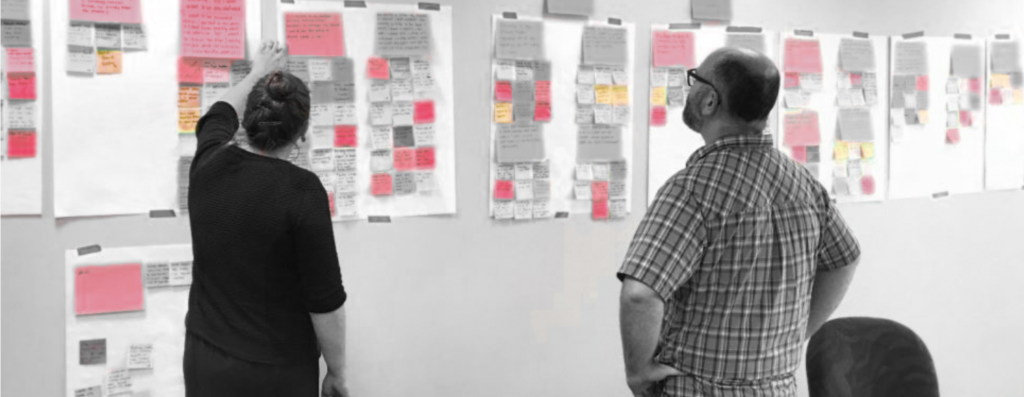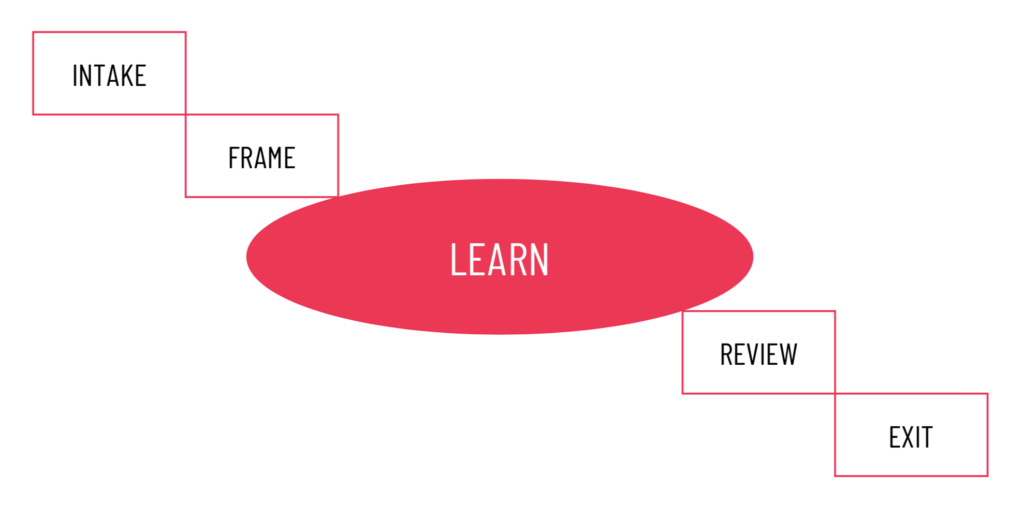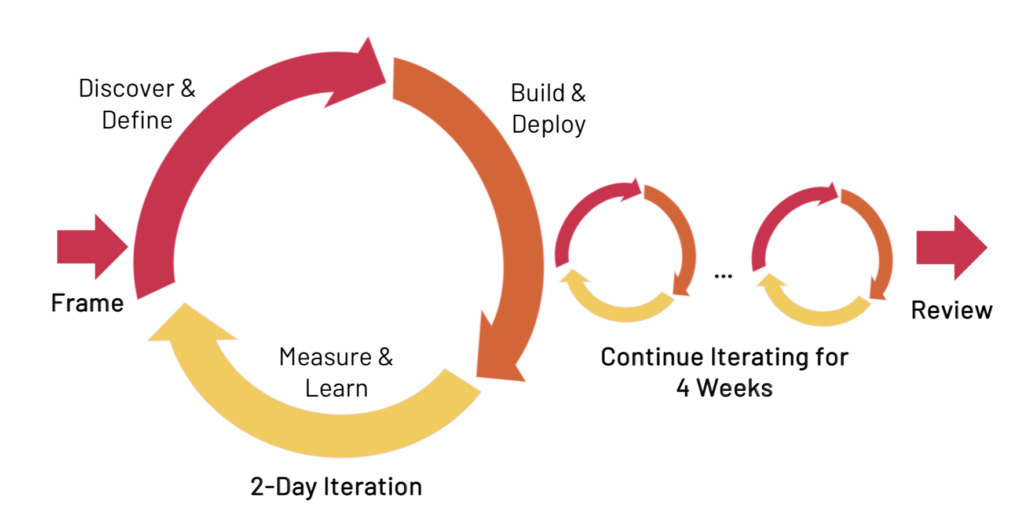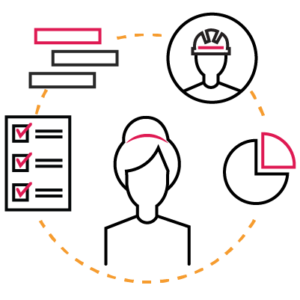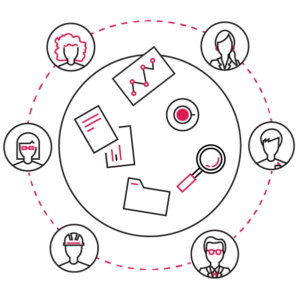What is a Dojo?
The word dojo, meaning “the place of the way,” comes from Japanese martial arts. It is an honored place where students and masters come together for deliberate practice to develop their skills.
In organizations, a Dojo is where teams learn complex skills, practices, and tools that help them develop better products faster. Dojos use immersive learning. Teams participate in Dojo experiences, typically referred to as “challenges,” in which they build real products and work from their actual backlogs with the entire process led by one or more coaches.
Target Corporation was the first to adopt this concept for mastering Product, Lean, Agile, and DevOps (PLAiD). DevJam (which was eventually acquired by Cprime and expanded into Product Agility), helped them design and implement the model.
What do people learn in a Dojo?
The Dojo emphasizes the relationship between Agile, Product, and Tech, and teams will learn how to integrate the three.
What are some of the challenges faced by organizations that might make them think about doing a Dojo?
Many teams haven’t realized the full impact of a DevOps transformation because they have poor Agile implementation and practices from the outset. It may be a waterfall process wrapped in Agile terminology.
The Dojo will help modify these practices and will demonstrate an outstanding model and implementation of Agile. It will challenge teams and help them make necessary adjustments to their own Agile implementation.
The Dojo will emphasize adopting a product mindset rather than a project orientation if the team hasn’t already.
What are the benefits/outcomes of a Dojo?
As other teams see examples of improved ways of working, they begin to change, accelerating the rate of change across the entire enterprise. Stories are powerful change agents! Graduates of the Dojo become evangelists for modern practices and Dojo concepts, which can help uplift other teams they join and interact with.
In addition, the improved capabilities of these teams lead to accelerating the delivery of business value—mainly if teams are working in a product model.
Ultimately, Dojos are expected to provide sufficient return on investment (ROI) by accelerating transformation time, speeding the scaling of the transformation across the organization, and improving organizational learning and adaptability. All of these are critical contributors to transformation efforts meeting business expectations.
What are the Dojo core principles?
The Dojo approach is more principle-driven than process-driven. It is a methodology that grows and evolves based on experience and experimentation. There are a few principles common to most Dojos: core tenets that define the Dojo as a concept.
- Prioritize learning over delivery.
- Align learning to the team’s actual work.
- Focus on safety, not on failure.
- Work small and exploit feedback.
- Make everything visible.
- Use the buddy system.
- Success depends on commitment.
What is the structure of a Dojo?
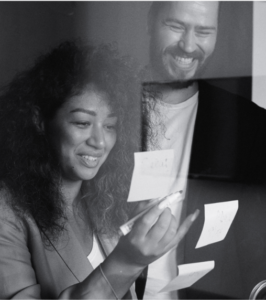
Dojos started as physical locations, chock full of whiteboards, where teams went for six weeks, getting out of their regular environment with all of its distractions, and focusing on learning topics relevant to their work. Since then, the Dojo approach has become more flexible, whether your employees are on-site or remote.
Why do Dojos work?
Let’s start with what doesn’t work and why. Training workshops, especially the 2-day variety, help build awareness, but they fail when attendees go back to their home teams and are confronted with the usual tyranny of the urgent. It’s hard to place new knowledge into practice when you’re overcome by business as usual. Learning through simulation or contrived exercises doesn’t always translate.
Here’s what does work:
Real Work: Dojos couple learning to a team’s actual work. Learning using a team’s real problems in their real systems in their existing code with their actual customers dramatically increases the relevance and “stickiness” of what they’re learning.
Dial Down Delivery Pressure: When you’re under the gun to deliver all of the time—hurrying to polish the latest feature, dealing with product support incidents, playing whack-a-mole with defects—it’s almost impossible to carve out time for continuous improvement and learning. In Dojo challenges, we negotiate with a team and their stakeholders to reduce delivery pressure by 50% or more to create space for learning. We’re consciously slowing down to work on strategies that may speed us up by increasing our deliveries’ relevancy (the right thing) and quality (the right way).
Rapid Iteration, Deliberate Practice, Spaced Repetition: We iterate rapidly. Twice weekly, we’ll go through planning, hands-on work, sharing our work with our stakeholders, and reflection on the prior iteration to decide what we should do and learn next.
Practicing a complex skill repeatedly and methodically helps team members build muscle memory around what they’re learning. This deliberate practice increases the chances of adopting what they’re learning and continuing to perfect their technique.
Safe-to-Fail Environment: We encourage experimentation in the Dojo. Beyond being empowered, team members are encouraged to suggest and try new ideas and involve the group in these explorations. We eschew blame and welcome failed attempts as rich learning opportunities opening the door to the next, better experiment.
Focus & Commitment: Ultimately, it’s the people in the Dojo that determine success. Is your leadership behind the effort and involved? Are your coaches capable and collaborating elbow to elbow with the teams? Is the team committed, engaged, and curious during the period of their challenge?
Why is working in a Dojo so effective?
The Dojo solves many of those problems commonly experienced by students, leading to a much higher rate of adoption of new methods after the “class” is over. To understand why, let’s break down what a typical Dojo experience looks like.
The Dojo Challenge describes a scheduled period during which a particular team enters the Dojo for immersive training. There’s no set time frame, but six weeks is a typical length. The Challenge breaks down into five basic sections:
- Intake
- Frame
- Learn
- Review
- Exit
During intake, the trainers take a few hours to introduce the team to the Dojo experience. They discuss what’s expected of them, what they can expect to get out of the training, and how to get the most out of the brief time they have. Generally, leadership will have had some input on what skills, processes, or goals the Dojo trainers will focus on, but students will often influence training goals as well.
Then, the frame offers the opportunity for guided planning. The team decides as a body what work they’ll be doing—notably, this is actual production work they’ll be completing as they learn—and how they’ll determine success. The initial product discovery and design thinking tasks are completed as well, usually over the course of two days.
The longest phase of the Dojo Challenge is the learning phase. During this period, the team will work through a string of microsprints lasting about two days each. Each two-day microsprint includes the familiar iterative cycle:
- Discover and Define
- Build and Deploy
- Measure and Learn
Successful teams will often forego ceremonies in favor of maintaining a productive flow. However, because the iterations are so accelerated, the team has a unique opportunity to rapidly learn and optimize their technical skills and agile chops. Work is done collaboratively, sometimes even teaming up on one task at one machine (a learning tactic called Mob Programming.) They’re usually amazed at just how productive, efficient, and creative they can be under these unusual constraints.
After the learning phase concludes, the team does a review that serves much like a sprint retrospective. Beyond going over what was taught and accomplished during the Challenge, the focus is on improving the Dojo experience for future classes.
Finally, the team returns to their typical working environment at the exit, hopefully with a suite of new skills and experiences they’ve already put into practice during the intensive, immersive Dojo training.
While a two-day sprint is rarely appropriate for everyday development work, it is common for Dojo trainees to opt for shorter production sprints or a faster deployment cadence once they learn it’s possible to be productive at speed.
More importantly, they’ve had an uninterrupted chance to immerse themselves in learning skills through a constant combination of instruction and application. By the time they leave the Dojo, the new skills are part of their working pattern. Inertia is no longer a hindrance, and there’s no need to rely on unreliable memory. Finally, since the Dojo environment is designed to train an entire team at once, ongoing application of learned skills can be supported by the whole team, easing the transition into “regular” work.
What kinds of teams/job roles are the best candidates and will benefit most from the Dojo experience?
Teams who generally benefit the most from the Dojo experience are:
- A full-stack, multidisciplinary team; “two-pizza” team
- Able to attend in-person (recommended, but not required)
- Able to commit at least six hours a day, investment for four to eight consecutive weeks
- Committed to learning
- Able and willing to combine Agile, Product, and Technology
Do Dojos only work if my company has implemented Agile and is no longer working under a waterfall project management methodology?
The maximum power of the Dojo occurs when it becomes a nexus of learning and immersion for Agile principles, product development, and technology adoption. Building the right things in the right way ultimately creates the most value for an organization. If the Dojo can bring these three elements together, teams will maximize their potential to change and transform successfully.
That being said, a Dojo is also not a purely Agile or Lean coaching practice. The focus should be on creating more effective teams, and that requires bringing together multiple practice areas. A Dojo works best when teams are hands-on with both new technology and product development approaches.
How long does a Dojo last?
Dojos typically last about six weeks. However, the program is flexible, so a Dojo coach can work with your organization to determine the best length for your needs.
What do Dojo coaches do?
Dojo coaches combine coaching chops, particularly within the constraints of the Dojo, with other skills in product development, engineering, workflow, et al. Not only have they done what they’re teaching and coaching, walking the walk, they know how to help others find success. In this sense, a Dojo coach is much like a team-oriented lead or senior member of staff. They’ve had success in an area, and now they enjoy teaching others to do the same.
How is a Dojo different from a typical training class?
A Dojo takes a team through a multi-week experience where they slow down delivery to accomplish both product objectives (refining or extending a product in terms of scope or quality or investing in their infrastructure) and learning objectives (mastering new complex skills). In a challenge, the team iterates very quickly, twice a week. During the challenge, the team collaborates with one or more coaches who have expertise in the skills the team would like to learn. When a team graduates their 6-week challenge, they can call on coaching support to sustain and grow their skills.
What does a typical Dojo look and feel like?
View a Dojo virtual tour to understand the Dojo model, the principles behind it, what to expect from it, how to measure success, and how to blend it effectively into your transformation efforts.
What is a typical day like in a Dojo?
The Dojo coach leads the day’s activities. Every day in a challenge has core hours; usually, 9 AM to 3 PM or 10 AM to 4 PM. The intent with core hours is to commit to
being together to collaborate as a team. That’s a sweet spot that gives everyone, team members and coaches, a couple of hours to catch up on communications, tend to other matters, or mentally recover and process the day.
The Pomodoro Method is used in the Dojo and typically a “double-Pomodoro approach” is used. Work is done in 50-minute increments, followed by a 10-minute break. Teams are strongly encouraged to take a full hour for lunch.
What happens when a team leaves the Dojo?
At the end of a team’s Dojo challenge, they have one final demo, the same as they do for each iteration, with this one focusing on the overall outcomes of their Dojo challenge, including what they’ve learned and improved about themselves. The team also has an exit interview with their coaches, where they talk about what they want to learn next, and how they want to apply what they’ve learned as they return to their normal environment. The coaches also set up an aftercare plan with the team, which may include the coaches visiting the team and coaching them in their space, or the team returning to the Dojo for a short stint to remind themselves of what they learned or even learn something new.
Learn More About Our Dojo Offerings >>
Cprime provides the expertise to help your Dojo take off — in virtual mode or face-to-face. We offer a complete package for creating an immersive learning environment built on the Dojo model. Facilitated workshops guide your organization through strategy and tactical planning, and expert coaches provide the knowledge and experience to get it off the ground. By the end of the engagement, the new Dojo is running and has emerging internal competency to continue delivery.
